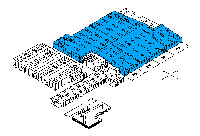PT&P has received a contract to design, develop and furnish all of the supporting systems for a 250 kW fuel cell unit prototype. Greg P. Michaels and Kishor Bhalara represented PT&P in this venture, designing the alloy supports for the piping and equipment. See below for a look at the fuel cell. PT&P’s contributions are shown in dark green.
Fuel cell technology is a cutting-edge advance in the field of energy production. Though in principle fuel cells have been in development for over 150 years, today’s refinements and prototypes have put the units closer to commercial availability than ever before. During the “space race” of the 1950s and 1960s, NASA launched fuel cells into space for electrical generation on its Gemini and Apollo missions. Today, they are regularly used in space shuttle missions. Until recently, the high cost of fuel cells made them prohibitively expensive for commercial use. However, experts are now predicting a drop in the price per fuel cell kilowatt, and have even ventured that as much as 60,000 MW of power will be produced by fuel cell in the year 2010.
The fuel cell works on a simple though significant principle. Fuel cells produce power by converting chemical energy directly into electrical energy, without requiring work like that done by a rotating generator. As the need for mechanical work is eliminated, the efficiency of the fuel cell increases dramatically. If a fuel cell takes advantage of cogeneration technology as well, the overall efficiency of the unit skyrockets to between 80 and 90 percent, unheard of in conventional power generation schemes. See the diagram below for a look at PT&P’s contributions to this revolutionary advance in energy production technology.
Piping Technology and Products, Inc. is thrilled to be a part of this piece of history. This prototype is certain to profoundly affect the way the world gets its power in the future. PT&P continues to look toward the twenty-first century in our quest for innovation and excellence.
Read More

